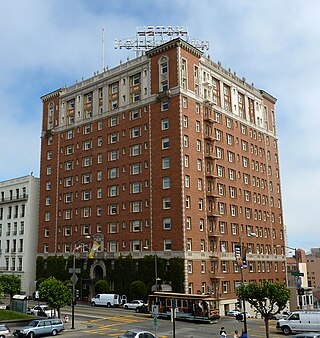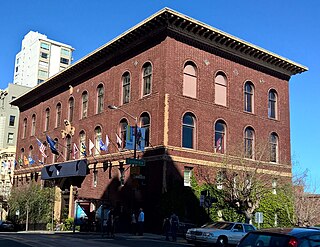Related Research Articles

Bernard Ralph Maybeck was an American architect in the Arts and Crafts Movement of the early 20th century. He was an instructor at University of California, Berkeley. Most of his major buildings were in the San Francisco Bay Area.

John Galen Howard was an American architect and educator who began his career in New York before moving to California. He was the principal architect at in several firms in both states and employed Julia Morgan early in her architectural career.

Sacramento Valley Station is an Amtrak railway station in the city of Sacramento, California, at 401 I Street on the corner of Fifth Street. It is the thirteenth busiest Amtrak station in the country, and the second busiest in the Western United States. It is served by four different Amtrak train routes and connecting Amtrak Thruway motorcoaches. It is also the western terminus for the Gold Line of the Sacramento RT Light Rail system and the Route 30 bus serving Sacramento State University.

The Westin St. Francis, formerly known as St. Francis Hotel, is a hotel located on Powell and Geary Streets on Union Square, San Francisco, California. The two 12-story south wings of the hotel were built in 1904, and the double-width north wing was completed in 1913, initially as apartments for permanent guests. This section is referred to as the Landmark Building on the hotel's website. The 32-story, 120 m (390 ft) tower to the rear, referred to as the Tower Building, which was completed in 1972, features exterior glass elevators that offer panoramic views of the bay and the square below, making the St. Francis one of the largest hotels in the city, with more than 1,254 rooms and suites.
Lewis Parsons Hobart was an American architect whose designs included San Francisco's Grace Cathedral and Macy's Union Square, several California Academy of Sciences buildings, and the 511 Federal Building in Portland, Oregon.

Albert Pissis (1852–1914) was a prolific Mexican-born American architect, of French and Mexican descent. He was active in San Francisco and had studied at the École des Beaux-Arts in Paris, France. He is credited with introducing the Beaux-Arts architectural style to San Francisco, California, designing a number of important buildings in the city in the years before and after the 1906 San Francisco earthquake.

Weeks and Day was an American architectural firm founded in 1916 by architect Charles Peter Weeks (1870–1928) and engineer William Peyton Day (1886–1966).

Hart Wood (1880–1957) was an American architect who flourished during the "Golden Age" of Hawaiian architecture. He was one of the principal proponents of a distinctive "Hawaiian style" of architecture appropriate to the local environment and reflective of the cultural heritage of the islands. He was one of the three founders of the Honolulu Chapter of the American Institute of Architects, and the only one of its fourteen charter members to be elected a Fellow of the AIA. He served as territorial architect during World War II.
Otto Karl Kleemann, frequently alternatively spelled Otto Kleeman, was an American architect in Portland, Oregon. His work included the design for Portland's Hotel Arminius and St. Patrick's Roman Catholic Church and Rectory.

Reid & Reid, also known as Reid Brothers, was an American architectural and engineering firm that was active from 1880 to 1932. Established in Indiana by Canadian immigrants, the firm moved to the West Coast and became was the most prominent firm in San Francisco, California in the late 19th and early 20th centuries.

William F. Curlett and Alexander Edward Curlett were a father-and-son pair of architects. They worked together as partners under the name of William Curlett and Son, Architects from c. 1908–1916. Aleck Curlett partnered with Claud Beelman as Curlett & Beelman (1919–1932).

Marston, Van Pelt, & Maybury and associated partnership names were architects in Pasadena, California.

Henry William Cleaveland was an American architect based in New York, New York, and then San Francisco, California, and Portland, Oregon. He was one of the founding members of the American Institute of Architects, and several of his works have been listed on the National Register of Historic Places. His works include Ralston Hall, a National Historic Landmark in the San Francisco Bay Area, the original Palace Hotel in San Francisco, and the Bidwell Mansion in Chico, California.

The University Club of San Francisco is a private social club located atop Nob Hill in San Francisco, California. Notable members have included President Herbert Hoover and conservationist John Muir.

The U.S. Post Office, also known as the Willows Main Post Office or US Post Office–Willows Main, is the main post office in Willows, California. Built in 1918, the post office was designed by Walter D. Bliss and William B. Faville, architects known for their work in San Francisco. The building was designed in the Italianate and Beaux-Arts styles. The building's roofline and arched arcade entrance with Doric columns were inspired by the Italianate style, while its detail work, including terra cotta reliefs, quoining, and decorative keystones, is Beaux-Arts styled. While many Italianate Beaux-Arts post offices were built in the early 20th century, the Willows post office was one of the few built in California. In addition, it is one of the few ornately designed buildings in Willows and has been called the "most sophisticated and imposing" of those which exist.
Walter Danforth Bliss (1874-1956) was an American architect from California. Many of his buildings are listed on the National Register of Historic Places.

The Baker and Hamilton Building, also known as Pacific Hardware and Steel Company Building and Baker, Hamilton and Pacific Company, is a historic office building and former commercial building built in 1905, and located in South of Market at 601 Townsend Street in San Francisco, California.

The San Rafael Improvement Club, at 1800 5th Ave. in San Rafael, California, was built in 1915. It was listed on the National Register of Historic Places in 1984.

The Beezer Brothers were American architects active from the late 19th-century to the Great Depression. They were twins, who practiced together in western Pennsylvania before moving to Seattle, Washington in 1907 to participate in the city's rapid growth brought on by the Klondike Gold Rush. Best known for the many Catholic churches they designed, they also worked on domestic residences and municipal buildings. Their work on the west coast, while concentrated in Seattle, can be found from Los Angeles to San Francisco to Alaska, and inland to Montana. At least one church and two buildings are individually listed on the National Register of Historic Places, and several other buildings are contributing properties to several different National Historic Districts.
References
- 1 2 "William Baker Faville". Pacific Coast Architecture Database.
- 1 2 3 4 5 6 7 "National Register Information System". National Register of Historic Places . National Park Service. November 2, 2013.